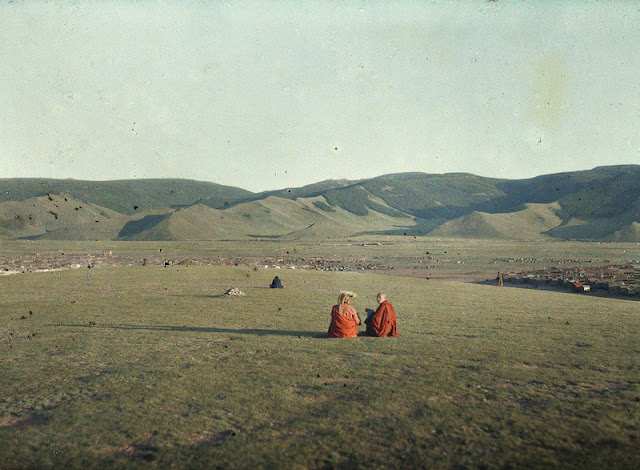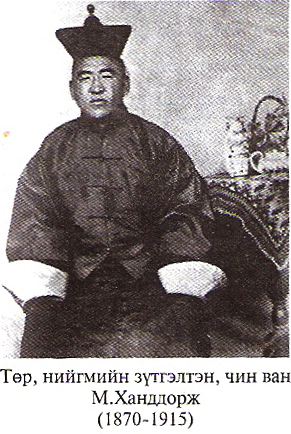Protectorate Mongolia, 1913

ЭРДЭНЭ БИШИРЭЛТ ОРОЙН ДЭЭД АЛТАН ХАРУУЛ ДАРХАН
ЗАСАГТ ХААН ДОРЖПАЛАМЫН СОДНОМРАВДАН
Монгол Улсын Шашин төрийг хослон өрнүүлэгч, Улсын эх дагина Д.Дондогдулам
Монгол Улсын Ерөнхий сайд Сайн ноён хан С.Намнансүрэн
1912-1919 онд Ерөнхий сайд Сайн
Монгол Улсын Гадаад хэргийг эрхлэн шийтгэгч яамны тэргүүн сайд Чин Ван Ханддорж
1911-1918
Монгол Улсын Ерөнхий сайд бөгөөд дотоод яамны сайд Жалханз хутагт С.Дамдинбазар
1920-21 онд Ерөнхий сайд: 22-23 онд Дотоод яамны сайд
Монгол Улсын Дотоод хэргийг бүгд захиран шийтгэгч яамны тэргүүн сайд, Да лам Г.Цэрэнчимэд
Монгол Улсын Сангийн хамаг хэргийг бүгд захиран шийтгэгч яамны тэргүүн сайд Түшээт ван Г.Чагдаржав
Монгол Улсын Цэргийн хэргийг бүгд захиран шийтгэгч яамны тэргүүн сайд С.Гомбосүрэн
Монгол Улсын Шүүх таслах хэргийг бүгд захиран шийтгэгч яамны тэргүүн сайд Гүн Э.Намсрай
Төрийн их хаш тамга
Бага мөнгөн тамга
Шашины алтан тамга
Улсын эх дагины мөнгөн тамга
Монгол улсын Ерөнхий сайд, Шанзодба Г.Бадамдорж
Монгол Улсын Ерөнхий сайд .Б.Цэрэндорж /Хичээнгүй сайд/ 1915-1919, 1922-23 онд Гадаад хэргийн сайд 1923-1928онд Ерөнхий сайд
Daliv hutagt
Bogdiin hatan Dondogdulam
Undur gongor
Ardiin zasgiin hoyordoh yurunhii said Jalhanz hutagt Damdinbazar


Лама у буддийских ступ
( Свернуть )Два солдата казака в Урге, 1913 г.
Замужняя женщина в Урге
Без подписи
Бадамдорж - религиозный деятель и премьер-министр в 1919-1920 г.
Ламы у Желтого дворца.
Храм.
Урга 23 июля 1913 г.
Улочка в Урге
Триумфальные ворота дворца Богдо-гэгэна
Урга в 1913 г.
Урга в 1913
Без подписи
Без подписи
Без подписи
Субурганы
Без подписи
Без подписи
Поселение кочевников во Внутренней Монголии. Китай
Два всадника-бурята в Троицкосавске
Экипаж Стефана Пассе между Кяхтой и Ургой
Субурганы
Охотник в окрестностях Урги, 1913
Монгольская женщина, приговорённая к голодной смерти
Монгольские юрты. 1913
Без подписи
Монгольские юрты
Буддийский дацан, Забайкалье
Буддийский дацан, Забайкалье
Портрет великого ламы Селенгинского дацана
Маймачен. Вход в китайский храм.
Маймачен. Губернатор
Маймачен. Китайские купеческие дома
Маймачен. Китайский храм
Маймачен. Телеги, запряженные буйволами
Маймачен. Уличная сцена
Маймачен. Уличная сцена.
Виды и типы Монголии. 1925. Часть 1
источник
источник 2
( Свернуть )
аг
WITHIN HER RED WEDDING CHAIR THE BRIDE GOES TO HER NEW LORD
Marriage in China brings in its train a host of restrictions and penalties which the bride submissively suffers. On becoming engaged she retires into the strictest seclusion, and intercourse even with her own brothers is greatly curtailed. Her trousseau is conveyed before her marriage in grand procession to her future home. Later, the bride herself is borne in state to the house of her new lord and master whom she has probably never seen
QUAINT FREAKS OF FASHION THAT PLEASE MONGOLIAN WIVES
PRINCE OF THE MONGOLS IN IMPERIAL GARB
Padded shoulders with chequered sleeves of grotesque length are the salient points of these ladies' strange dress, which shows how world-wide is the desire for adornment extraordinary. But the crowning effect is produced by the winged headdress through which the hair is threaded, hanging pendent from the extremities. Shoes with pointed toes complete this truly surprising accoutrementWith the dignity that befits his position, this princely descendant of the great Tartar khans, Jenghiz and Kublai, sits, proud in the consciousness of ancestors whose power was a terror and whose name a fear through all the bounds of Asia
TRAPPINGS THAT BESET A MONGOL PRINCESS
MEN OF MONGOLIA VERSED IN MYSTERIOUS LORE
Royal lineage and regal adorning grace this Mongolian princess in her bejewelled and beaded headdress that rustles with soft clash at every movement of her head. The full, smooth cheeks and narrowing eyes are the dominant features of her raceYellow-robed brothers of the Yellow Faith, they are for ever telling their rosaries, whispering the orison, or turning the prayer wheels. Many of these lamas, who make one-third of the population, gather together forming separate communities, their convents being mere clusters of tents. Great respect is paid to them, and they are readily supported by the laity |
ONE OF THE WONDERS OF THE WORLD: CHINA'S GREAT WALL
"FANATICS HAVE THEIR DREAMS"
Built over two hundred years before the Christian era, and reconstructed once or twice, the Great Wall winds its way like some great snake for some 1,400 miles along the northern border of the old empire to lose itself in the west. Built as a defence against Tartar hordes, and rising supreme above all obstacles, it is so thick that two carriages can be driven abreast on its rampartFrom under the hood of this Buddhist priest of Lin Yin the sombre eyes of a fanatic look forth, while his folded arms suggest, not meekness, but the resolution written in the set jaw
FEATHERED DEATH FROM THE ARCHER'S HAND
|
SKILLED ACCOMPLISHMENT OF THE VERSATILE HUNGUS
| |
| With his stout arc at full stretch this Manchurian bowman stands, feet apart and arms braced, to speed his fleet shaft to the distant mark. He uses his belt for a quiver, though its carrying capacity as such is rather limited | Among other ways of obtaining a living some of the Hungus give conjuring performances at which they have attained considerable skill. This particular adept in sleight of hand is not merely content to emphasize that there is nothing up his sleeve, but, to make the feat more marvellous, has stripped to the waist. Despite all this, he is successful in producing a bouquet from his mouth |
MANCHURIAN LADIES AND THEIR FLOWER-DECKED HEADGEAR
ROBED IN THE RAIMENT OF AUTHORITY
Those of Manchuria's women who enjoy the more leisured walks of life have a certain daintiness of mien and charm of habiliment, especially in the matter of hats. But they are not free from the Chinese persuasion that small feet are the essential adjunct of true beauty, and these ladies have squeezed their toes into quaint and delicate contrivances that cover unpleasing deformityIn the East, power usually manifests itself in the outward seeming, and the Hungus make no exception to this rule. Here is a functionary who fulfils roughly the duties of aide-de-camp to a bandit chief
AMONG THE RANK AND FILE OF THE MONGOLIAN POPULATION
MODERN DESCENDANT OF JENGHIZ KHAN
Social differences in Mongolia are usually defined by the size of a man's herds or the number of his servants. Though sparing by nature, hospitality — according to their means — is the outstanding virtue of the Mongols, but a childlike simplicity in their dealings with neighbors is apt to be abused, and astute Chinese succeed in winning their confidence, usually to their detrimentHis thick winter overcoat of silk with its embroideries and fur cuffs, and his handsome boots, proclaim him a man of means in Mongolia. He belongs to the Lama Church, and devoutly practises all its easier observances
CENTAUR OF THE WILD EASTERN PLAINS
|
COMMERCIAL FOLK OF THE HIGH REGIONS OF NEPAL
| |
| Of their many, old formidable qualities the Mongols retain but few; their extraordinarily fine horsemanship has, however, in no way diminished — undoubtedly due to their inherent laziness, for they appear to be unwilling to use their own legs | They come of a mountaineering stock and carry on a business in wool and skins which they barter with Tibetans in exchange for foodstuffs, and are often employed as yak-hands. Most of the races occupying Nepal are of mixed Mongol origin; usually short, robust of build, with flat faces, oblique eyes, and yellow-brown complexions, their appearance is decidedly Mongoloid |










































































































No comments:
Post a Comment